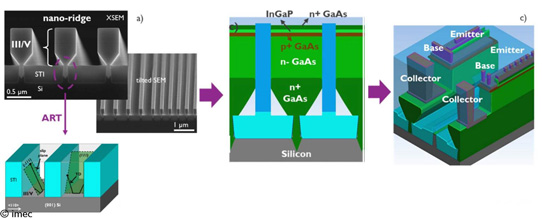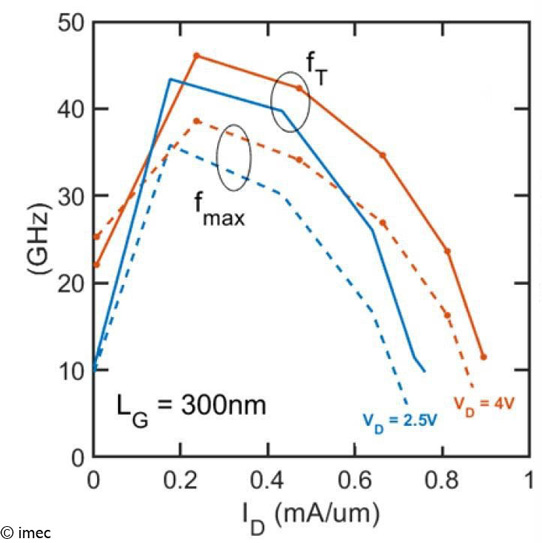News: Microelectronics
10 January 2020
Imec demos scalable III-V and III-N devices on silicon, targeting beyond-5G RF front-end modules
Demonstrating the potential of both III-V-on-Si and GaN-on-Si as CMOS-compatible technologies for enabling RF front-end modules for beyond-5G applications, nanoelectronics research centre imec of Leuven, Belgium presented the first functional gallium arsenide (GaAs)-based heterojunction bipolar transistor (HBT) devices on 300mm silicon as well as CMOS-compatible gallium nitride (GaN)-based devices on 200mm silicon for millimeter(mm)-wave applications at December’s IEEE International Electron Devices Meeting (IEDM 2019) in San Francisco, and is featuring them in a keynote presentation by Michael Peeters (imec’s program director connectivity + humanized technology) on consumer communications beyond broadband at the IEEE Consumer Communications and Networking Conference (CCNC 2020) in Las Vegas (10-13 January).
In wireless communication, with 5G as the next generation, there is a push towards higher operating frequencies, moving from the congested sub-6GHz bands towards mm-wave bands (and beyond). The introduction of these mm-wave bands has a significant impact on the overall 5G network infrastructure and the mobile devices. For mobile services and fixed-wireless access (FWA), this translates into increasingly complex front-end modules that send the signal to and from the antenna. To be able to operate at mm-wave frequencies, the RF front-end modules will have to combine high speed (enabling data rates of 10Gbps and beyond) with high output power.
In addition, their implementation in mobile handsets puts high demands on their form factor and power efficiency. Beyond 5G, these requirements can no longer be achieved with today’s most advanced RF front-end modules that typically rely on a variety of different technologies, including GaAs-based HBTs for the power amplifiers – grown on small and expensive GaAs substrates.

Picture: Description of the NRE approach for hybrid III-V/CMOS integration on 300mm silicon: (a) nano-trench formation (defects are trapped in the narrow trench region); (b) HBT stack growth using NRE; and (c) different layout options for HBT device integration.
“To enable the next-generation RF front-end modules beyond 5G, imec explores CMOS-compatible III-V-on-Si technology,” says Nadine Collaert, program director at imec. “Imec is looking into co-integration of front-end components (such as power amplifiers and switches) with other CMOS-based circuits (such as control circuitry or transceiver technology) to reduce cost and form factor, and enabling new hybrid circuit topologies to address performance and efficiency,” he adds. “Imec is exploring two different routes: (1) indium phosphide (InP) on silicon, targeting mm-wave and frequencies above 100GHz (future 6G applications) and (2) GaN-based devices on silicon, targeting (in a first phase) the lower mm-wave bands and addressing applications in need of high power densities. For both routes, we have now obtained first functional devices with promising performance characteristics, and we identified ways to further enhance their operating frequencies.”
Functional GaAs/InGaP HBT devices grown on 300mm silicon have been demonstrated as a first step towards the enablement of InP-based devices. A defect-free device stack with a threading dislocation density below 3x106cm-2 was obtained by using imec’s unique III-V nano-ridge engineering (NRE) process. The devices are said to perform considerably better than reference devices, with GaAs fabricated on silicon substrates with strain relaxed buffer (SRB) layers. In a next step, higher-mobility InP-based devices (HBT and HEMT) will be explored.

Picture: Measured cut-off frequencies of the current gain (fT) and unilateral power gain (fmax) for GaN/AlGaN devices on 200mm silicon.
Moreover, CMOS-compatible GaN/AlGaN-based devices on 200mm silicon have been fabricated comparing three different device architectures – HEMTs, MOSFETs and MISHEMTs. It was shown that MISHEMT devices outperform the other device types in terms of device scalability and noise performance for high-frequency operation. Peak cut-off frequencies of fT/fmax around 50/40 were obtained for 300nm gate lengths, which is in line with reported GaN-on-SiC devices. Besides further gate-length scaling, the first results with AlInN as a barrier material show the potential to further improve the performance and hence increase the operating frequency of the device to the required mm-wave bands.








